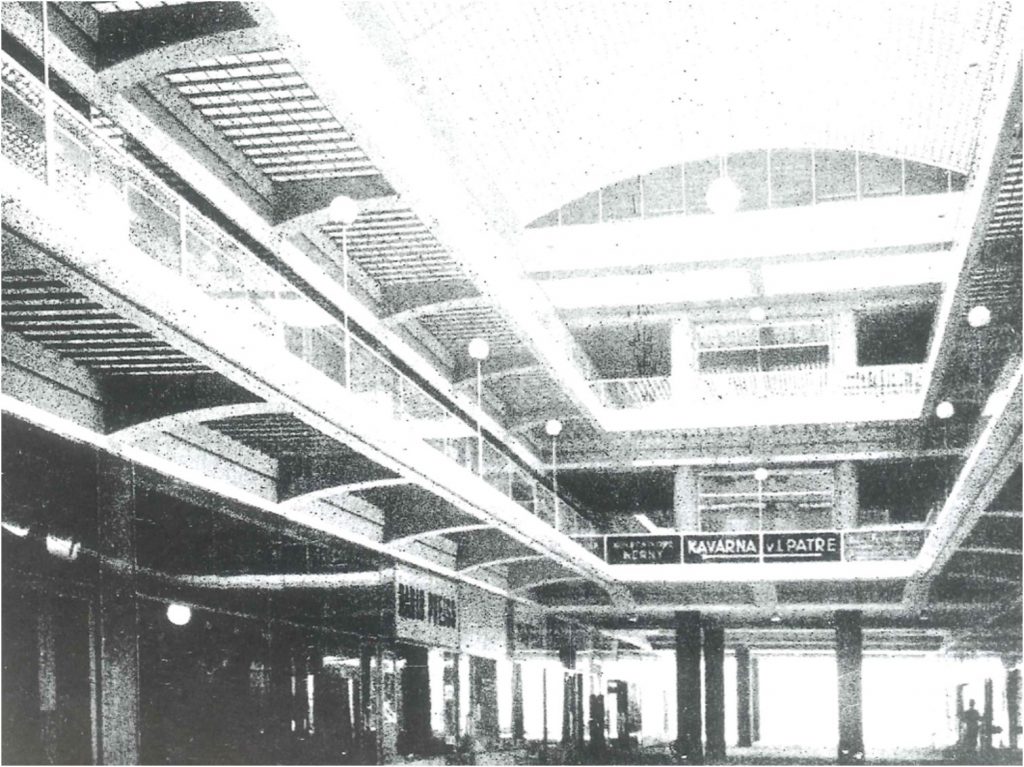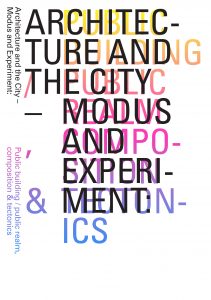How to Design Public Space for Maritime Mindsets? That’s a central question in the new Minor ‘Minor (Re)Imagining Port Cities: Understanding Space, Society, and Culture’.
Tag Archives: public building
[Re]Thinking Cities

2020: A Year without Public Space under the COVID-19 Pandemic!
new publication of The Journal of Public Space
The Journal of Public Space published ‘2020: A Year without Public Space under the COVID-19 Pandemic’. This monumental publication of 280 pages witnesses the year we all lived on social distance dictated by COVID-19 health emergency, a measurement severely affected everyone’s access to public space and with it creating a range of impacts on different levels. Delft University of Technology, as a worldwide recognised leader in the field of urban design and public space, united with more than twenty universities globally to question; how can we face this unprecedented emergency and get prepared to its consequences, with specific regard to health disparity? Will public space restrictions stay in place after the recovery period? Should we just aim to return to a pre-COVID status quo, or for a ‘better normal’? And more generally, what will be the future of public space?
Maurice Harteveld, part of the scientific board, remembers how the situation induced by the COVID-19 crisis in early 2020 immediately brought together the global community of experts on the Design of Public Space; “I remember how the alarm bells didn’t stop anymore in the third week of April. Health situation worsened progressively in China, and a new decree imposing quarantine became in act in Northern Italy. Public space was abandoned there. Without doubt, we started to share local insights and form a global perspective on the issues arising from the pandemic for public space the current situation of public space.” Together with UN-Habitat, the United Nations Human Settlements Programme, this became an opportunity to collaborate to re-think how cities should be.
As the pandemic was moving across different continents and urban conditions, through shared online initiative public space experts across the world exchanged experiences of care, solidarity, entrepreneurship, academic perspectives, artistic interpretations, and creative practices of human resilience, engaging more than 100 speakers during 20 webinars from May to September 2020, and more than 2,700 registered attendees from over 80 countries, including representatives from UNHabitat. Global impact of the online initiative ‘2020: A Year without Public Space under the COVID-19 Pandemic’ has been even broader by counting more than 72,000 page views in that same period. This publication encapsulates key learnings globally from the early stage of the pandemic, which stand relevant to this day when we face squarely the same issues as we step into gradually and navigate the post-COVID era.
Download full issue here
Pasáži Renesance
Prague has more arcades than Paris. Still, they are less known. This is unfortunate, because these arcades underlining the identity of Prague and the Czech Republic. This is underpinned particularly during the 1990s arcade renaissance. New arcades have been designed, like Pasáž Jiřího Grossmanna (1995 –1996), Rathova Pasáž (1996), and the redesign Hrzanska Pasáž of 1702-1704 (1996). These projects have upgraded existing arcade systems, introduced new styles, but foremost new hopes… It echoed an update on the Czech Awareness.
Throughout history we have seen this happen in the design of arcades in Prague. This particular study brings us back to the rise of Bohemian identity and unfolds an epistle illuminating an alternative arcade project. As such, the study reframes relations between design of public space and society and provides a way to understand shifts in these.

Pasáže Černé Růže (1936), by Oldřicha Tyla
Pražské Pasáže
Arcade Projects in Prague
Public Buildings | Urban Architectural Design | Contextual Assignment
as projects for people, and projects within Society
Architecture and the City
The Architecture and the City: Public Realm/Public Building research group of the Faculty of Architecture and the Built Environment, Delft University of Technology focuses on questions regarding the mutual relationship between the city and its public realm. This is a relationship that can only be considered in socio-cultural and economic context. The idea of the public realm here refers to an intermediate ‘space’, which facilitates and mediates between different groups of inhabitants and individuals; the idea of the public realm as the space of (ex)change of ideas, opinions and beliefs of the different groups of users. Therefore, the architecture of the city and its actual qualities form the main framework of this research. Within this context urban blocks, as interface between architecture and urban design, and public buildings are seen as crucial architectural elements. Their functioning and organisation are physically, symbolically, socially and economically fundamental to the city. As such they form a domain both of architectural convention and experimentation. In terms of research and design methods architectural typology, typo-morphology and research-by-design hold a central position in our group’s approach.
Constructing the Commons
Conference
Constructing the Commons at
Delft University of Technology
3rd – 4th March 2016
Faculty of Architecture and the Built Environment
Julianalaan 134
2628 BL Delft
Investigating ‘the commons’ at the intersection of philosophy, sociology and architecture, keynote speakers Atelier Bow-Wow, Richard Sennett, Margaret Crawford, Paola Viganò and George Baird, discuss the city, public space and social practices during this conference.
Continue reading
Expo goes Guangzhou
|
Design Exhibition Reclaiming the Human Space at South China University of Technology on invitation of 8th – 15th November 2015 School of Architecture |
设计展区 重塑人性空间 华南理工大学 邀请方 2015年11月8日至11月15日 建筑学院 |
| Continue reading | |
Reclaiming the Human Space
|
Delft University of Technology and Beijing University of Technology at Beijing Design Week Exhibition 1 Reclaiming the Human Space 23rd September – 30th October 2015 The Nurturing House, Dashilar In the past decade, Beijing has focused on overall strategies for its rapid urban development. New functional zones, land-use layout, and a comprehensive traffic system, laid the basis for a booming urban economy, and widespread social wealth. Iconic buildings by global starchitects, including works by the ‘Big Dutch’, are evidence of this development. The city has been reshaped. Yet, along its motorways, and in its streets and alleys, we see other images of the city. People feel lost, houses are dilapidated, and the quality of urban spaces is relatively low. The current generation of international design students is taking on these big small-scale issues. Their designs show a more human-centred approach. Therefore, they take the culture of the city as their starting point and work across disciplines in search of answers. A clear paradigm shift. The collaborating universities of technology in Delft and Beijing strongly support this people-oriented approach by means of research. Here they present the outcome of recent studio work as a visual manifesto, forecasting four major challenges in the long-term development trend of the city: Humanisation of Infrastructural Wastelands; Integration of Modernist Fragments; Recreation of Community Places; Rehabilitation of Daily-Life Environments. |
代尔夫特理工大学与 北京工业大学在 北京国际设计周 第一展区 重塑人性空间 2015年9月23日至10月30日 保苖民居,大栅栏 过去几十年间,高速发展是北京城市建设的主旋律。新的功能组团、土地使用区划和综合性的交通系统构成了城市经济发展和社会财富积累的基础。包括荷兰建筑师在内的明星建筑师们所设计的标志性建筑物,就是这一时期的产物。城市在被重新塑造着。但是,在城市快速路的两侧,在街道边,在小巷里,我们看到的是不同的城市景象。人们失去了他们曾经拥有的,房屋在逐渐老化而城市空间的质量在相对下降。这里所呈现的学生联合设计作品面对的正是这一重要却又往往被忽视的议题。他们的设计所秉承的是一种更加人性化的态度,然而却从城市的文化角度出发,通过跨学科的合作寻求答案。这无疑是种范式的转变。代尔夫特理工大学与北京工业大学的合作从研究的意义上为这种以人为本的设计方向提供了强有力的支持。本次展览所展现的学生作品可视为一次视觉上的宣言,预告了城市长期发展趋势中面临的四项主要挑战:基础设施建设的人性化、现代主义城市空间的整合、社区场所的再造、以及日常生活环境的复兴。 |
| Continue reading |
|
Design for the People
|
Delft University of Technology and Beijing University of Technology at Beijing Design Week Exhibition 2 Design for the People 23rd September – 7th October 2015 The Shijia Hutong Museum Annex Within boosting big-scale Beijing, community-based spatial action gain exposure. Top-down development and market oriented real-estate is supplemented by communal initiatives. Participatory design is emerging. People ask themselves: How can we make our common courtyards and alleyways more attractive places to linger? Members of the Shijia Hutong Area are pioneering in initiatives inquired by design. Their recently opened museum is one of the many projects. At this place and together with their local partners, the universities of technology of Beijing and Delft present the exhibition ‘Design for the People’ to the public. It showcases a wide set of interrelated design issues inspired and supported by locals: Social investigation and among others the recording of hutong oral history show that improvements on their own living environment are free from any theoretical disciplinary restraint. Their suggestions to strengthen micro-economy derive from local entrepreneurship. Their appreciation for historic streets come from their own memory. Likewise, one will discover that the combat with the increase transport and tourism is foremost their own struggle. In this expo daily issues matter. These have inspired collaborating young designers to rethink issues on a local level. By visualising physical improvements and emphasising the added value for the people, now these designers aim to inspire locals vice versa. Therefore, local residents and visitors are invited to vote for their favoured future. |
代尔夫特理工大学与 北京工业大学在 北京国际设计周 第二展区 为人民设计 2015年9月23日至10月7日 史家胡同博物馆 在北京的大规模城市建设中,以社区为基础的空间规划行为逐渐显现出其重要性。社区层面的主动性成为了自上而下的规划建设与市场导向的房地产开发的补充。参与式设计越来越普遍。人们不禁会自问:如何将我们共用的院落或胡同变成更加宜人的场所?史家胡同所在的社区就是实践这一理念的先行者,而新近建成开放的史家胡同博物馆则是其中的一个典型案例。与当地的合作伙伴一道,北京工业大学和代尔夫特理工大学以“为人民设计”为题在这里向公众展示我们的工作成果,内容包括一系列与社区合作进行的、相互关联的设计项目。社会调查与胡同口述史的纪录展现了人们对于改善他们自身生活环境的需求和为之进行的努力,而这些并未为我们理论上所谓的学科差异所限。他们认同当地小商业对于微观经济的贡献;他们怀念记忆中的历史街巷;同样地,他们发觉不断增大的车流和过度的旅游开发是首要面对的挑战。日常生活是这次展览的重点,并将促使合作参与的年轻设计师们重新思考社区层面的议题。通过体现物质空间质量的改善及强调其对于社区居民的意义,设计师们也向居民们提供了新的思路。同时,社区居民和参观者也有机会投票选择他们中意的设计。 |
| Continue reading |
|
10yrs of Graduation Projects
Liveability and Public Space in the Happy City
9th September 2015, 8:45-10:30h
Lecture
Delft University of Technology
Room: IO-Bernd Schierbeek
Landbergstraat 15
Delft
My faculty in Delft is one of the world’s largest in the field of architecture and urban design. “It is a place that is buzzing with life from early in the morning until late at night, with four thousand people studying, working, designing, conducting research and acquiring and disseminating knowledge*.” In this environment, I have supervised quite some graduates in their final master thesis, all focussed on liveability and public space. What can we learn from them and how to proceed?
Liveability and Public Space in the Happy City [download pdf]
Everyone Contributes
Singapore has been undergoing a fast growth scheme in a short time frame. No single person, no single firm or institution, not even a single government can solve all themselves. So, within the international Vertical Cities Asia competition, exactly this is challenged in the Paya Lebar area. How to house hundred-thousand people per square kilometre in the future?

